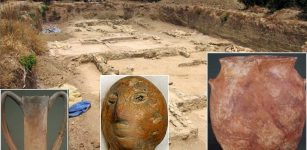Before Ragnarok: Horrifying Fimbulwinter In Norse Mythology Was Based On Real Events
Ellen Lloyd - AncientPages.com - In Norse mythology, Ragnarok (Ragnarök) is the world's end as the Vikings knew it.
The concept of fate dominates Norse mythology, and to the Norse people, fate was a fact of life that could not be avoided or changed.
This immutable concept culminates in Ragnarok (Ragnarök) – “the darkness of the gods,” the coming destruction of the world, whose inevitability is impossible to fight with.
Ragnorok represents the world undergoing major upheaval and some dramatic changes that will take place.
There are going to be warning signs that Ragnarok is coming. One of them is horrifying Fimbulwinter. It is an extremely cold and long winter that lasts three years without a summer.
Image credit: ex3me - Pixababy - Public Domain
During those three years, there will be many wars, and all people and animals will perish in the end. There will only be two survivors, Líf and Lífþrasir, who will live in the forest of Hoddmímis holt.
In Denmark, Norway, Sweden, and other Nordic countries, the term Fimbulvinter is also used to refer to an unusually cold and harsh winter.
The devastating Fimbulwinter (‘The Great Winter’) has long been considered nothing but a myth, but this view has changed in recent years.
Scientists are now seriously considering the possibility the Fimbulwinter described in Norse mythology was based on real events.
Fimbulwinter is described in the first part of the Poetic Edda, an unnamed collection of Old Norse anonymous poems, which is different from the Edda, written by Snorri Sturluson (1179 – 1241), a famous Icelandic historian.
"Odin and Fenriswolf, Freyr and Surt" (1905) by Emil Doepler via wikipedia
In the Gylfaginning section of the Prose Edda, Swedish King Gylfi, the earliest recorded king in Scandinavia, visits a hall where a triple throne confronts him at the home of the gods, one being seated and occupied by another.
He asks them what the gods know about the Fimbulwinter. The three gods tell him there will be three winters in a row and no summer in between.
The gigantic monter-wolf Fenrir will come loose. In Norse mythology, Fenrir symbolizes the chaotic and destructive power of nature. He represents the most tremendous dynamic forces coming from underground.
Fenrir will kill the god Odin during the events of Ragnarok, but in turn, he will also be killed by Odin’s son Víðarr.
Then something strange will happen. The event will be visible in the skies. The wolf will be the three Norse gods explaining to king Gylfi that the Fimbulwinter precedes Ragnarok, the world's destruction.
Researchers think Fimbulwinter is related to the extreme weather events of 535–536, which resulted in a notable drop in temperature across northern Europe.
According to other ancient sources, this was a period when the Sun was bluish, weak, and obscured. People threw no shadow on the ground, and even the Moon was obscured. There was no heat, and the crops died. This must have been due to a large volcanic eruption and subsequent ash cloud spreading worldwide. This outbreak was previously unknown, but researchers have come across evidence, such as ice cores from Greenland, confirming extreme weather conditions at the time.
In Northern Sweden, after year after year 536, the average temperature during summer dropped by three to four degrees.
This indicates strong climate changes led to increased mortality among humans. Very old grave findings and depictions on ancient runes stones offer evidence of a very harsh and long winter period.
It is, therefore, possible that the Fimbulwinter described in Norse mythology was based on real events.
Updated on February 1, 2023
Written by - Ellen Lloyd AncientPages.com
Copyright © AncientPages.com All rights reserved. This material may not be published, broadcast, rewritten or redistributed in whole or part without the express written permission of AncientPages.com
More From Ancient Pages
-
 Baby God Hermes Started His Life As A Liar And Trickster
Featured Stories | Dec 25, 2020
Baby God Hermes Started His Life As A Liar And Trickster
Featured Stories | Dec 25, 2020 -
 Mystery Of The 2,000-Year-Old ‘Urn Burial’ Ceremonies: 113 Tombs Discovered Near the Ancient City Of Fudi
Archaeology | Oct 11, 2016
Mystery Of The 2,000-Year-Old ‘Urn Burial’ Ceremonies: 113 Tombs Discovered Near the Ancient City Of Fudi
Archaeology | Oct 11, 2016 -
 Adorable Village Of The Little People In Connecticut
Featured Stories | Jul 25, 2019
Adorable Village Of The Little People In Connecticut
Featured Stories | Jul 25, 2019 -
 Ötzi The Iceman’s Stomach Bacteria And Complex History Of European Settlements
Archaeology | Jan 8, 2016
Ötzi The Iceman’s Stomach Bacteria And Complex History Of European Settlements
Archaeology | Jan 8, 2016 -
 Ancient Tools Found In Maryland Re-Write The History Of First Humans In America
Archaeology | May 29, 2024
Ancient Tools Found In Maryland Re-Write The History Of First Humans In America
Archaeology | May 29, 2024 -
 Violent Conflict Played A Crucial Role In Early Farming Societies In Neolithic Europe – New Study
Archaeology | Jun 19, 2023
Violent Conflict Played A Crucial Role In Early Farming Societies In Neolithic Europe – New Study
Archaeology | Jun 19, 2023 -
 Human Skeleton Dated To Parthian Era Unearthed At Tepe Ashraf In Iran’s City Of Isfahan
Archaeology | Jul 25, 2020
Human Skeleton Dated To Parthian Era Unearthed At Tepe Ashraf In Iran’s City Of Isfahan
Archaeology | Jul 25, 2020 -
 Forseti: Norse God Of Justice And Lawmaker Who Lived In A Shining House
Featured Stories | May 1, 2016
Forseti: Norse God Of Justice And Lawmaker Who Lived In A Shining House
Featured Stories | May 1, 2016 -
 One Of The Oldest Manuscripts Fragments Of The Famous Merlin Legend Discovered
Archaeology | Sep 2, 2021
One Of The Oldest Manuscripts Fragments Of The Famous Merlin Legend Discovered
Archaeology | Sep 2, 2021 -
 Forgotten Notebook Reveals Da Vinci Understood Gravitiy Long Before Newton
Ancient Technology | Feb 22, 2023
Forgotten Notebook Reveals Da Vinci Understood Gravitiy Long Before Newton
Ancient Technology | Feb 22, 2023 -
 Legendary Helike – Uncovering Lost City of Poseidon
Civilizations | Dec 19, 2018
Legendary Helike – Uncovering Lost City of Poseidon
Civilizations | Dec 19, 2018 -
 Rare 3,000-Year-Old Weavings Discovered In Alaska
Archaeology | Sep 4, 2023
Rare 3,000-Year-Old Weavings Discovered In Alaska
Archaeology | Sep 4, 2023 -
 Ancient Scar Dragon Plaque And The Viking Boat To The Otherworld
Artifacts | Feb 4, 2016
Ancient Scar Dragon Plaque And The Viking Boat To The Otherworld
Artifacts | Feb 4, 2016 -
 Sumerians Built A Huge ‘Anti-Drought Machine’ To Save Ancient City Of Girsu From Destruction
Ancient Technology | Nov 23, 2023
Sumerians Built A Huge ‘Anti-Drought Machine’ To Save Ancient City Of Girsu From Destruction
Ancient Technology | Nov 23, 2023 -
 Reconstructing The Lost Ancient World Of The Marquesas Islands With Unique Plants And Animals
News | Mar 31, 2022
Reconstructing The Lost Ancient World Of The Marquesas Islands With Unique Plants And Animals
News | Mar 31, 2022 -
 Ancient DNA Sheds New Light On The Link Between The European Huns And The Xiongnu Empire
DNA | Feb 26, 2025
Ancient DNA Sheds New Light On The Link Between The European Huns And The Xiongnu Empire
DNA | Feb 26, 2025 -
 Palnatoke – Founder Of The Jomsvikings Brotherhood, Legendary Danish Hero And Enemy Of King Harald Bluetooth
Historical Figures | Nov 2, 2016
Palnatoke – Founder Of The Jomsvikings Brotherhood, Legendary Danish Hero And Enemy Of King Harald Bluetooth
Historical Figures | Nov 2, 2016 -
 Hidden Ancient Citadel In The Mayan City Of Tikal Discovered By LIDAR
Archaeology | Sep 28, 2021
Hidden Ancient Citadel In The Mayan City Of Tikal Discovered By LIDAR
Archaeology | Sep 28, 2021 -
 Is ‘Someone’ Regularly Altering The Course Of History? – Unexplained Events – Part 2
Ancient Mysteries | Dec 3, 2020
Is ‘Someone’ Regularly Altering The Course Of History? – Unexplained Events – Part 2
Ancient Mysteries | Dec 3, 2020 -
 Ancient Graffiti On Sacred Mountain Reveals Secrets Of North Korea
Archaeology | Dec 3, 2021
Ancient Graffiti On Sacred Mountain Reveals Secrets Of North Korea
Archaeology | Dec 3, 2021



